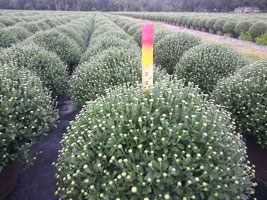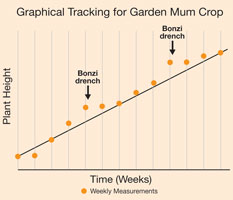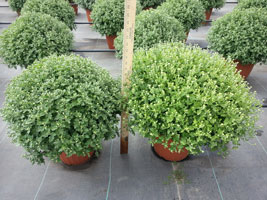4/28/2014
What’s New in Garden Mums?
Bernard Chodyla
It’s amazing how garden mum production has changed in the last 20 years. I just checked my notes from the mid-’90s, when I worked as a head grower for a large greenhouse operation in Florida and there were Yoder mums only on my list. Varieties like Symphony, Marilyn, Brandi and Raquel were the main varieties in my mix and definitely the best choices at that time. Most of them had an upright growth habit and were capable of stretching several inches in one week during hot, rainy weather. Dr. Jim Barrett from the University of Florida was teaching us about the benefits of Bonzi drenches and not everyone had the luxury of using drip irrigation. Times have changed and now growers have many tools at their disposal to reliably produce garden mum crops.
1 | By far the greatest improvement was made in garden mum genetics. The introduction of Belgian mums in North America prompted other companies to breed for more rounded shapes, flexibility and better branching. The “Belgian type” of garden mum became the most popular and desirable among growers and sought-after by consumers. The Staviski family from GroLink is a prime example of a garden mum that was recently introduced and is quickly becoming the new favorite among growers and for very compelling reasons. All colors within the family are perfectly rounded, the plants are very flexible and have identical vigor and flower dates, which allows growers to use them for mixed color combinations. They’re very suitable for both outside and inside production, and under blackout with a short, 6.5-week response time. These new genetics require no pinch and will perform well in any size container by adjusting grow time and with little or no PGR use.
 Figure 1. Graphical tracking allows growers to select several plants from each variety and measure them weekly.
Figure 1. Graphical tracking allows growers to select several plants from each variety and measure them weekly.
2 | The graphical tracking was introduced a long time ago, but surprisingly, few growers use it to track their garden mum crops. You need to collect and analyze data in any business to make the right decisions and graphical tracking allows you to do just that. Growers select several plants from each variety and measure them weekly (Figure 1). The measurements are then plotted on the simple graph where a straight line connects the initial height point at transplanting and the expected final size at finish (Figure 2). This straight line represents the function of time and growth, so every time the measurements fall too far from the line, you should act accordingly. An excessive growth should be countered promptly with less water, reduced fertilization and ultimately PGRs. The opposite should be considered in case of insufficient growth. It’s always best to combine the graphical tracking with weekly soil analysis to see the whole picture.
 3 | The fertility plays a major role in garden mum production and should be used as a main tool to control growth and development.
3 | The fertility plays a major role in garden mum production and should be used as a main tool to control growth and development. Growers now have a choice of genus-specific fertilizers that were designed to fulfill special nutrient requirements and prevent deficiencies. Fertilizers like Mum FeED or Acid Special are very effective in lowering the soil pH and contain a higher percentage of iron chelate, which is essential in garden mum production. As a result, the ability to maintain slightly acidic pH throughout the growing season and make iron more available helps to reduce the overall fertilizer use and to maintain healthy and green foliage.
Figure 2. Graphical tracking data is a simple graph where a straight line connects the initial height point at transplanting and the expected final size at finish.
The growth is always controlled not by the total amount of nutrients available to the plant, but by the least abundant nutrient. Hence, garden mums will perform well under a constant feed regime with lower rates of NPK and sufficient levels of trace elements. The cost savings could be significant, as long as the injector is well calibrated and operational at all times. The same could be achieved with a low to medium rate of properly selected slow-release fertilizer incorporated into the growing media. Small amounts of well-balanced nutrients become available on a daily basis and are consumed by the plants where very little leaching occurs. These new trends could be great for increasing profits, but the consequences of insufficient feeding could outweigh any benefits and are very severe—general purpling, stunted growth, brittleness and missed sales.
4 | Controlling phosphorus levels in the growing media could be the best growing tool and least expensive PGR there is. Most soil mixes come with a starter charge that contains phosphorus in the form of phosphates. Garden mums will benefit from increased phosphorus availability in early stages since it regulates protein synthesis and, thus, increases cell division and new tissue development. Most fertilizers with a P/N ratio higher than 0.5 contain sufficient amounts of phosphate and ammoniacal nitrogen to cause the “miracle growth” effect in plants. Growers should know when to reduce the amount of phosphorus and control growth before plants get too stretchy and soft, requiring PGR use. In some cases, too much phosphorus and nitrogen could turn into a very costly affair with Bonzi drenches.
 5 | The new phenomenon of “Fascinating” garden mums and other crops is quickly gaining popularity among growers.
5 | The new phenomenon of “Fascinating” garden mums and other crops is quickly gaining popularity among growers. Fascination could and should be used on mums when all other cultural practices—including proper scheduling, lighting, Florel, increased fertilization and watering—failed to create enough growth. It’s also important to recognize the size issue early enough and spray Fascination several weeks before mums begin cracking color. Starting with low rates, such as 5 ppm weekly, creates more controlled and uniform stretch compared to 15 to 20 ppm applied one time at the last minute (Figure 3).
Figure 3. 15 ppm Fascination spray on the right and the control on the left, seven days after application.
6 | Paclobutrazol (Bonzi) is becoming the number one PGR in garden mum production. It provides reliable growth control in plug production, where plants are sprayed with rates as high as 10 ppm, and on finished garden mums as a drench, with rates ranging from 1 to 6 ppm. This popularity is somewhat attributed to the ease with which Bonzi could be applied through the drip tape. Unfortunately, this is where growers often make mistakes by not paying attention to the volume of drench and plants become stunted.
The 1-ppm Bonzi solution will have a different PGR effect depending on the volume applied, so 8 oz. of 1-ppm solution will have twice the active ingredient as 4 oz. of the same 1-ppm solution. Also, some growers spray surprisingly high rates of paclobutrazol before shipping garden mums in order to increase their shelf life at the stores. Thanks to that, plants appear very hard, but allegedly stay green and fresh longer then untreated plants. Daminozide (B-Nine) is also widely used as a spray, but comparing to paclobutrazol, it’s known to delay flowering if applied too often or too late in the crop. Any of these PGRs applied properly and in combination with graphical tracking could be an excellent tool in achieving the target size.
7 | When customers demand large garden mums with height spec of 27 in., the mum netting has become a must-have tool. The new varieties have incredible flexibility, but even the best crops get damaged by heavy downpours or rough handling at garden centers. Growers regard the mum netting as inexpensive crop insurance and the math is very simple: losing 10 large plants to splitting or breakage at a wholesale value of $10 each would pay for more than 1,000 pieces of green netting. The net is applied when plants reach 70% of their final size so the branches grow through it and the net is positioned 3 to 4 in. below the plant canopy at the time of color. Plants supported with netting ship and sell better and last longer for the consumer.
8 | Lastly, the oldest principle of growing garden mums and used by the best growers is keeping good notes and updating your cookbook each season. This will eventually allow you to achieve a Starbucks-like consistency and most customers will crave your product. Season after season, you’ll get the same perfect quality, more demand, zero shrink and higher profits. Sometimes the most obvious and long-forgotten tools should be reintroduced and could produce the biggest returns on investment for growers.
GT
Bernard Chodyla is Technical Support at GroLink for Belgian Mums in the U.S. and Canada. He can be reached at bernard@grolink.com.